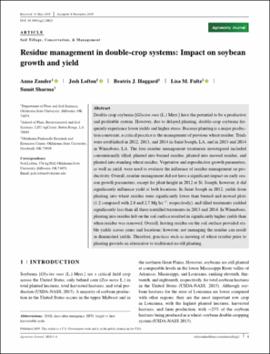| dc.contributor.author | Zander, Anna | |
| dc.contributor.author | Lofton, Josh | |
| dc.contributor.author | Haggard, Beatrix J. | |
| dc.contributor.author | Fultz, Lisa M. | |
| dc.contributor.author | Sharma, Sumit | |
| dc.date.accessioned | 2022-03-29T13:32:57Z | |
| dc.date.available | 2022-03-29T13:32:57Z | |
| dc.date.issued | 2020-03 | |
| dc.identifier | oksd_zander_residuemanagementindoublecrop_2019 | |
| dc.identifier.citation | Zander, A., Lofton, J., Haggard, B. J., Fultz, L. M., & Sharma, S. (2020). Residue management in double-crop systems: Impact on soybean growth and yield. Agronomy Journal, 112 (2), pp. 1433-1440. https://doi.org/10.1002/agj2.20021 | |
| dc.identifier.uri | https://hdl.handle.net/11244/335086 | |
| dc.description.abstract | Double-crop soybeans [Glycine max(L.) Merr.] have the potential to be a productive and profitable system. However, due to delayed planting, double-crop soybeans frequently experience lower yields and higher stress. Because planting is a major production constraint, a critical practice is the management of previous wheat residue. Trials were established in 2012, 2013, and 2014 in Saint Joseph, LA, and in 2013 and 2014 in Winnsboro, LA. The four residue management treatments investigated included conventionally tilled, planted into burned residue, planted into mowed residue, and planted into standing wheat residue. Vegetative and reproductive growth parameters, as well as yield, were used to evaluate the influence of residue management on productivity. Overall, residue management did not have a significant impact on early season growth parameters, except for plant height in 2012 at St. Joseph; however, it did significantly influence yield at both locations. In Saint Joseph in 2012, yields from planting into wheat residue were significantly lower than burned and mowed plots (1.2 compared with 2.8 and 2.7 Mg ha-1, respectively), and tilled treatments yielded significantly less than all three nontilled treatments in 2013 and 2014. In Winnsboro, planting into residue left on the soil surface resulted in significantly higher yields than when residue was removed. Overall, leaving residue on the soil surface provided stable yields across years and locations; however, not managing the residue can result in diminished yields. Therefore, practices such as mowing of wheat residue prior to planting provide an alternative to traditional no-till planting. | |
| dc.format | application/pdf | |
| dc.language | en_US | |
| dc.publisher | Wiley | |
| dc.relation.ispartof | Agronomy Journal, 112 (2) | |
| dc.rights | This material has been previously published. In the Oklahoma State University Library's institutional repository this version is made available through the open access principles and the terms of agreement/consent between the author(s) and the publisher. The permission policy on the use, reproduction or distribution of the material falls under fair use for educational, scholarship, and research purposes. Contact Digital Resources and Discovery Services at lib-dls@okstate.edu or 405-744-9161 for further information. | |
| dc.subject | 0703 Crop and Pasture Production | |
| dc.subject | Agronomy & Agriculture | |
| dc.title | Residue management in double-crop systems: Impact on soybean growth and yield | |
| dc.date.updated | 2022-03-28T21:01:35Z | |
| osu.filename | oksd_zander_residuemanagementindoublecrop_2019.pdf | |
| dc.description.peerreview | Peer reviewed | |
| dc.identifier.doi | 10.1002/agj2.20021 | |
| dc.description.department | Plant and Soil Sciences | |
| dc.type.genre | Article | |
| dc.type.material | Text | |
| dc.identifier.author | ORCID: 0000-0001-6412-6946 (Zander, A) | |
| dc.identifier.author | ScopusID: 57214598700 (Zander, A) | |
| dc.identifier.author | ORCID: 0000-0002-1644-4648 (Lofton, J) | |
| dc.identifier.author | ScopusID: 48261217200 (Lofton, J) | |
| dc.identifier.author | ScopusID: 36494686600 (Haggard, BJ) | |
| dc.identifier.author | ORCID: 0000-0002-5128-7879 (Fultz, LM) | |
| dc.identifier.author | ScopusID: 23012286300 (Fultz, LM) | |
| dc.identifier.author | ScopusID: 56528654900 (Sharma, S) | |
